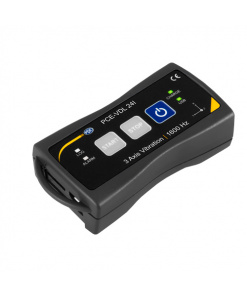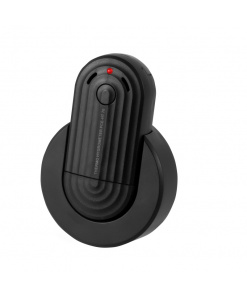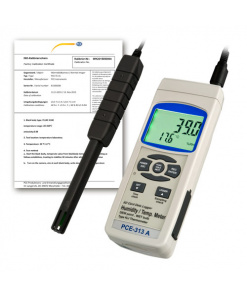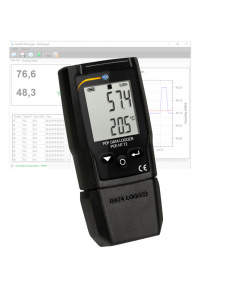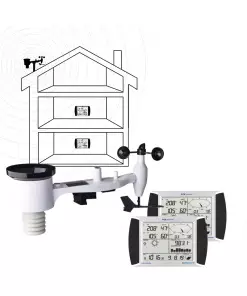Climate Data Logger Meter PCE-VDL 16I
PCE-VDL 16I
Availability : กรุณาติดต่อสอบถาม
Climate data logger meter
With up to 800 Hz / Temperature, Humidity, Air pressure, Vibration, and Light
The climate data logger meters of the PCE-VDL series are available in two versions. The climate data logger meter contains sensors for the following physical units: temperature, humidity, air pressure, light and 3-axis acceleration. The max. sampling rate of the acceleration sensor is 800 Hz, the remaining sensors are sampled with max. 1 Hz.
The climate data logger meter is therefore ideally suited for use in fault diagnosis, stress testing, machine inspection, shock measurements and preventive maintenance.
Why climate data logger?
The long-term (over weeks, months, even years) observed meteorological condition at a certain place is referred to as climate. 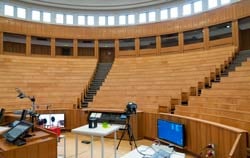 The factors that characterize climate are air temperature, humidity, air pressure, precipitation, wind, evaporation and radiation (based on air-climate). Air temperature, humidity and air pressure are probably the most important climatic factors. Due to the importance of these three climatic factors, the long-term climate monitoring / climate recording is essential – therefore, digital devices for long-term measurement, climate monitoring and recording of the measurement data, namely climate data loggers, are applied. In addition to the monitoring of the three already mentioned climatic factors (air temperature, air humidity, air pressure), these climate loggers can be meaningfully supplemented by further measuring parameters. Depending on the climate measuring task, it often makes sense to carry out the long-term recording of, for example, CO2, light intensity, UV radiation or, in the case of transporting processes, vibrations.
The factors that characterize climate are air temperature, humidity, air pressure, precipitation, wind, evaporation and radiation (based on air-climate). Air temperature, humidity and air pressure are probably the most important climatic factors. Due to the importance of these three climatic factors, the long-term climate monitoring / climate recording is essential – therefore, digital devices for long-term measurement, climate monitoring and recording of the measurement data, namely climate data loggers, are applied. In addition to the monitoring of the three already mentioned climatic factors (air temperature, air humidity, air pressure), these climate loggers can be meaningfully supplemented by further measuring parameters. Depending on the climate measuring task, it often makes sense to carry out the long-term recording of, for example, CO2, light intensity, UV radiation or, in the case of transporting processes, vibrations.
Applications
In addition to the classic application in museums, the climate data loggers are widely used in the transport monitoring of expensive and sensitive items. The climate loggers are also applied in the warehouse, in the area of facility management, in the office buildings, archives, in the pharmacy and in the cold storage houses.
Criteria for a purchase decision
Especially when it goes about the climate data logger, you should always put the long-term recording of the measurement data in the foreground. Therefore, among the most crucial features are a long battery life and a low sensor drift. 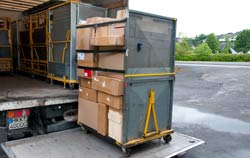 Of course, when purchasing, you should pay attention to such criteria, as the measurement uncertainty / accuracy and reproducibility, which are decisive for every measuring instrument, and also remember about the importance of easy handling of the stored measurement data (e.g. data stored on an SD card). The climate data logger should be very easy to handle and at the same time well equipped. If in addition, the evaluation software is scalable and allows for the measurement data to be displayed in a climate nomogram, then you have considered almost all the important criteria – almost, because there is still one more thing that should be taken into account: is the climate data logger adjustable? and calibratable? As a rule, exactly the sensors for measuring the relative humidity are subject to drift. In order to be able to counteract this negative feature, the sensors on the climate logger should be adjustable.
Of course, when purchasing, you should pay attention to such criteria, as the measurement uncertainty / accuracy and reproducibility, which are decisive for every measuring instrument, and also remember about the importance of easy handling of the stored measurement data (e.g. data stored on an SD card). The climate data logger should be very easy to handle and at the same time well equipped. If in addition, the evaluation software is scalable and allows for the measurement data to be displayed in a climate nomogram, then you have considered almost all the important criteria – almost, because there is still one more thing that should be taken into account: is the climate data logger adjustable? and calibratable? As a rule, exactly the sensors for measuring the relative humidity are subject to drift. In order to be able to counteract this negative feature, the sensors on the climate logger should be adjustable.
So that you could comply with the calibration intervals specified in your ISO manual and, if necessary, also provide your customers with calibration records for inspection, the climate dataloggers should always be calibratable.
Aside of the climate in its general global meaning, there are numerous microclimates which are essential for this or another particular place, situation and which are need to be sustained in order to provide the desired result, for example, growth, creation of comfortable and healthy environment, prevention of mold and bacteria development etc. climate data logger not only provides the user with the information about important parameters at a certain location, it also may serve as an instrument for detection of the main reasons why something goes in the wrong way: not low/high enough temperature, wrong humidity level, poor CO2 saturation. IN fact, climate data logger may also give an explanation to the poor well-being of people who are frequently at the same place. Not always it is possible to give a correct assessment of a certain environment and the initial impression may be temporary and false. To ensure that the conditions meet the requirements and a certain microclimate fits to the task or need, the data logger is a perfect solution, since over a longer period of time it may detect how stable the parameters are, how often they fluctuate and why. The advantage of the climate data logger is that it may be applied anywhere, even where the permanent presence of the human is not possible. This gives a chance to learn more about climatic condition in caves
| Temperature | |
| Measuring range | -20 … 65°C / -4 … 149°F |
| Accuracy | ± 0.2°C / ± 0.36°F |
| Resolution | 0.01°C / 0.018°F |
| Max. Sampling rate | 1 Hz |
| Humidity | |
| Measuring range | 0 … 100% r.H. |
| Accuracy | ± 1.8% r.H. |
| Resolution | 0.04% r.H. |
| Max. Sampling rate | 1 Hz |
| Air pressure | |
| Measuring range | 10 … 2000 mbar |
| Accuracy | ±2 mbar (750 … 1100 mbar); otherwise ± 4 mbar |
| Resolution | 0.02 mbar |
| Max. Sampling rate | 1 Hz |
| Light | |
| Measuring range | 0.045 … 188,000 Lux |
| Resolution | 0.045 Lux |
| Max. Sampling rate | 1 Hz |
| 3 Axes Acceleration | |
| Measuring range | ± 16 g |
| Accuracy | 0.24 g |
| Resolution | 0.00390625 g |
| Max. Sampling rate | 800 Hz |
สินค้าที่เกี่ยวข้อง
เครื่องวัดคุณภาพอากาศ
Climate Meter PCE-HT 71N-ICA Incl. ISO Calibration Certificate
PCE-HT 71N-ICA
เครื่องวัดคุณภาพอากาศ
PCE-VDL 24I
เครื่องวัดคุณภาพอากาศ
PCE-HVAC 3
เครื่องวัดคุณภาพอากาศ
PCE-HT 70
เครื่องวัดคุณภาพอากาศ
Climate Meter PCE-313A-ICA incl. ISO Calibration Certificate
PCE-313A-ICA
เครื่องวัดคุณภาพอากาศ
PCE-HT 72
เครื่องวัดคุณภาพอากาศ
PCE-FWS 20N-1
เครื่องวัดคุณภาพอากาศ
PCE-555




